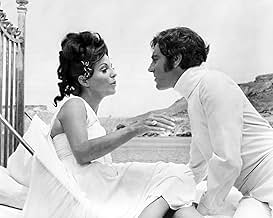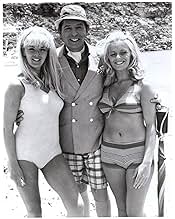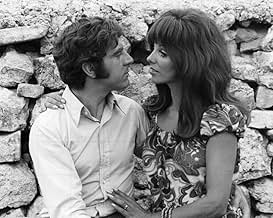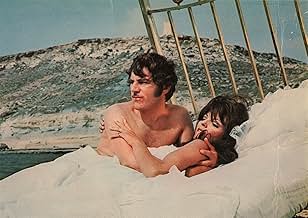VALUTAZIONE IMDb
4,9/10
433
LA TUA VALUTAZIONE
Aggiungi una trama nella tua linguaHeironymus Merkin screens an autobiographical movie of his life, growth, and moral decay.Heironymus Merkin screens an autobiographical movie of his life, growth, and moral decay.Heironymus Merkin screens an autobiographical movie of his life, growth, and moral decay.
- Regia
- Sceneggiatura
- Star
- Premi
- 1 vittoria in totale
Tara Newley Arkle
- Thumbelina
- (as Tara Newley)
Recensioni in evidenza
This is an extraordinary film. But it's not for everyone, and it must be viewed in it's context.
There was a time when Anthony Newley was one of the biggest stars in the world. With two hit Broadway musicals and a slew of movies under his belt, and songs STILL being covered by today's artists ("Feeling Good" is currently enjoying a popular resurgence courtesy of Michael Buble'"), Universal Studios gave him carte blanche to make any movie he wanted. Newley had already established a proved track record of using his own life as source material. Making this kind of film was a logical next step for him.
In many respects, this film is a masterpiece. It is utterly unique; visually beautiful, it looks like a lucid dream. Newley was a master of symbolism, and the way he illustrates different levels of reality and different states of consciousness is nothing short of brilliant. Highly "Jungian", this film is meant be viewed and interpreted like a dream. Many reviewers have lambasted "Heironumus" for it's use of symbolism, but on the contrary, that is the beauty and magic of the film. Anyone familiar with the Western Hermetic Tradition will delight in the eloquence with which this movie speaks. It cannot be an accident that "Heironymus" was filmed in Malta, the home of the Knights Templar. It makes one question how deeply into the occult Newley must have been.
PLOT SUMMARY: Heironymus Merkin, a major star, is making a film about his own life, told as a fairy tale/epic myth. He is screening it for his mother and two toddler children. It is his intent that his children know the truth about who their father is, warts and all. The film-within-the-film is still in production, and Heironymus battles with the studio, writers, and critics for the integrity of his personal truth.
The film is:
about mid-life crisis
an exposition of internalized toxic shame
an examination of the repetition compulsion
A confession
a cry for help
a treatise on the unreality of life
a rare look at celebrity-hood from a celebrity's point of view
a self-portrait of a sex-addict
a dissertation on erotic mania
AND it's a musical-comedy.
The movie is many things, confusing, because Newley was himself confused. Then again, aren't we all to some degree? The greatest thing about "Heironymus" is all the questions it brings up. It inspires deep process, and that is what makes it Art, and a true gift to the world.
I am committed to helping this film finding it's audience.
There was a time when Anthony Newley was one of the biggest stars in the world. With two hit Broadway musicals and a slew of movies under his belt, and songs STILL being covered by today's artists ("Feeling Good" is currently enjoying a popular resurgence courtesy of Michael Buble'"), Universal Studios gave him carte blanche to make any movie he wanted. Newley had already established a proved track record of using his own life as source material. Making this kind of film was a logical next step for him.
In many respects, this film is a masterpiece. It is utterly unique; visually beautiful, it looks like a lucid dream. Newley was a master of symbolism, and the way he illustrates different levels of reality and different states of consciousness is nothing short of brilliant. Highly "Jungian", this film is meant be viewed and interpreted like a dream. Many reviewers have lambasted "Heironumus" for it's use of symbolism, but on the contrary, that is the beauty and magic of the film. Anyone familiar with the Western Hermetic Tradition will delight in the eloquence with which this movie speaks. It cannot be an accident that "Heironymus" was filmed in Malta, the home of the Knights Templar. It makes one question how deeply into the occult Newley must have been.
PLOT SUMMARY: Heironymus Merkin, a major star, is making a film about his own life, told as a fairy tale/epic myth. He is screening it for his mother and two toddler children. It is his intent that his children know the truth about who their father is, warts and all. The film-within-the-film is still in production, and Heironymus battles with the studio, writers, and critics for the integrity of his personal truth.
The film is:
about mid-life crisis
an exposition of internalized toxic shame
an examination of the repetition compulsion
A confession
a cry for help
a treatise on the unreality of life
a rare look at celebrity-hood from a celebrity's point of view
a self-portrait of a sex-addict
a dissertation on erotic mania
AND it's a musical-comedy.
The movie is many things, confusing, because Newley was himself confused. Then again, aren't we all to some degree? The greatest thing about "Heironymus" is all the questions it brings up. It inspires deep process, and that is what makes it Art, and a true gift to the world.
I am committed to helping this film finding it's audience.
Little seen ego-trip for the resistible talents of writer/producer/director/composer/star Anthony Newley (featuring his then-wife Joan Collins) which, due to its copious and gratuitous nudity (including its creator!), is surely the most notorious production ever to be filmed in Malta and, consequently, something of a holy grail for local film buffs! Given its unavailability, then, I wasn't overly disappointed in the poor (but certainly not unwatchable) quality of the print and the film itself, possessing a certain sense of style, wasn't as worthless as its reputation would have it!
In itself, a flashy and pretentious semi-autobiographical piece obviously inspired by Fellini's 8½ (1963), it's largely set on a beach where the protagonist is apparently mounting a film based on his own life (how self-indulgent can you get?). In fact, what plot there is resolves itself into a music-hall revue with plenty of rather quaint musical numbers (one of which is reprised ad nauseam throughout) by Newley and others. These, however, are often interrupted by the surprising presence of legendary American showmen George Jessel (as a wise-cracking, white-clad Angel Of Death figure, dubbed "The Presence") and Milton Berle as the Mephistophelean Goodtime Eddie Filth.
Newley's choice of character names is, if anything, admirably Fieldsan: indeed, here, Heironymus Merkin is torn between Collins' Polyester Poontang and Playboy playmate Connie Kreski's Mercy Humppe (hence the film's unwieldy title). Occasionally, too, Merkin is able to step out of character in order to observe his own actions enacted, in the interim, by a blank-faced dummy! Also incorporated is an irrelevant adult-oriented fairy-tale, entitled "The Princess And The Donkey", involving the intimate relationship between one Trampolena Whambang and a mule (which then turns into a dwarf!); amazingly, this infamous sequence was filmed in Malta's Presidential Palace!! The cast includes other familiar faces such as Stubby Kaye as Merkin's long-suffering scriptwriter and Victor Spinetti as a bewildered film critic who, perhaps justly, blames Fellini for Merkin's (and, by extension, Newley's) folie de grandeur.
There's a possible goof, too, in the appearance of a religious statue in the background during one of the beach sequences; this was supposedly removed for filming purposes and, consequently, has been the cause of much consternation locally to this day! I'm also confused by the film's actual running time: the X-rated version I watched, which one would assume to be uncut, ran for 107 mins. (with the trimmed R-rated version being 106 mins. long) but the BBFC gives its complete length as 117 mins.!
In itself, a flashy and pretentious semi-autobiographical piece obviously inspired by Fellini's 8½ (1963), it's largely set on a beach where the protagonist is apparently mounting a film based on his own life (how self-indulgent can you get?). In fact, what plot there is resolves itself into a music-hall revue with plenty of rather quaint musical numbers (one of which is reprised ad nauseam throughout) by Newley and others. These, however, are often interrupted by the surprising presence of legendary American showmen George Jessel (as a wise-cracking, white-clad Angel Of Death figure, dubbed "The Presence") and Milton Berle as the Mephistophelean Goodtime Eddie Filth.
Newley's choice of character names is, if anything, admirably Fieldsan: indeed, here, Heironymus Merkin is torn between Collins' Polyester Poontang and Playboy playmate Connie Kreski's Mercy Humppe (hence the film's unwieldy title). Occasionally, too, Merkin is able to step out of character in order to observe his own actions enacted, in the interim, by a blank-faced dummy! Also incorporated is an irrelevant adult-oriented fairy-tale, entitled "The Princess And The Donkey", involving the intimate relationship between one Trampolena Whambang and a mule (which then turns into a dwarf!); amazingly, this infamous sequence was filmed in Malta's Presidential Palace!! The cast includes other familiar faces such as Stubby Kaye as Merkin's long-suffering scriptwriter and Victor Spinetti as a bewildered film critic who, perhaps justly, blames Fellini for Merkin's (and, by extension, Newley's) folie de grandeur.
There's a possible goof, too, in the appearance of a religious statue in the background during one of the beach sequences; this was supposedly removed for filming purposes and, consequently, has been the cause of much consternation locally to this day! I'm also confused by the film's actual running time: the X-rated version I watched, which one would assume to be uncut, ran for 107 mins. (with the trimmed R-rated version being 106 mins. long) but the BBFC gives its complete length as 117 mins.!
After watching this film, I wondered if Anthony Newley thought that this would be his sole chance to direct a major film (which turned out to be true), so he decided togo on a binge with every idea he had at that point . It's in equal parts a mockumentary, a musical, and an homage to Tex Avery cartoons. Newley is the ringleader, Hieronymus Merkin, and he invites us to watch his carnal accomplishments and rise as a singer.
This movie features some fascinating production and costume design, and the beach sets are very unique. The jokes often hit sour notes, but the enthusiasm is contagious. I mean, really, what's better than seeing Joan Collins portray a character named " Polyester Poontang"? If you ever come across this movie, give it a chance.
:)
This movie features some fascinating production and costume design, and the beach sets are very unique. The jokes often hit sour notes, but the enthusiasm is contagious. I mean, really, what's better than seeing Joan Collins portray a character named " Polyester Poontang"? If you ever come across this movie, give it a chance.
:)
As a performer (musical or otherwise), Anthony Newley has always been an acquired taste. His cabaret-born stylings and exaggerated delivery (again, while singing or acting) can either be interpreted as heartfelt or preening. Newley had done nothing on the screen up to this point to justify the jaded, indifferent, Felliniesque "Heironymus Merkin", an autobiographical jumble of vaudeville skits, sex and songs. Newley directed and has the lead; he also co-wrote the script with Herman Raucher, scored the music and produced. Obviously, this project meant a lot to him, but it was shunned upon its release (the ungainly title was most likely no help). The film gives off bad vibrations, as well as the puzzling impression it was made by somebody who hoped to get out of show business. A musical-comedy star reflects on his life upon turning 40 (the age, Merkin tells us, when men's bodies begin to decay); he's guided along his journey by George Jessel (dressed in all-white) and Milton Berle (dressed in suit jackets and shorts, like a leering carnival barker). Newley cavorts with a bevy of women (a handful of whom were featured in a nude Playboy layout, which figured in the advertising), but Merkin/Newley views sex cheerlessly. The women are sex objects to be ogled and then cheated on--until they get pregnant, which leads to the ultimate trap: marriage. While Newley is anxious to show off the bare breasts of his actresses (minus those of wife Joan Collins, who is turned into a shrew), he stops short of celebrating their bodies; in Newley's world, a sex scene is included only to showcase his prowess as a ladies' man. He's not only the star of his own movie, he's the leading man in each of his lovers' movies (the ladies have no personalities--only lascivious names). This self-adoration is probably the reason the film was taken to task by the critics, who called it a megalomaniacal disaster. Is it truly wretched? I would say Newley adopts a certain style from the Masters, which is unfortunately hindered in the end by the lenient editing. There are far too many shots of Newley with his shirt off, or with his shoes off, allowing the camera to admire him. He primps, he sticks out his bottom lip and looks boyish, he dresses as a life-size marionette and collapses, hoping to grab our hearts. The picture isn't a personal triumph because it has been shaped and styled to reveal Anthony Newley as a sad puppet, a crying clown, and the image is so false that nobody--least of all of Newley--could get away with it. *1/2 from ****
"Can Hieronymous Merkin ever forget Merci Humppe and find true Happiness?" has to win an award for being the strangest title for a film ever. Partially semi autobiographical comedy in the vein of Fellini and Woody Allen. "Hieronymous Merkin" throws away conventional narrative to tell the story of a director making a film about his life; not to mention it's also a musical. Some parts are dated and hard to follow. Director Anthony Newly was married to Joan Collins. Collins also appears in the film. Collins has a certain expression like, how did I end up in this film? All criticism aside, "Hieronymous Merkin" is quite funny and breathtaking with it's amazing surrealist imagery. If Woody Allen, Fellini and Jodorowsky were to of collaborated on a musical with Jacques Demi, it may be something like this film. Newly can get annoying at times with his inflated ego and sex drive. He tells about marriage, infidelity, having kids, being in show business and his various sex-capades. Memorable dream like images include the Merry go round sequence, Merkin as a string puppet, his bed which lies in the ocean on the beach side and a crazy sequence with a nude girl who is a human wind up toy like object. I sure wish they would release this film on DVD. There are not many films like it. Love it or hate it, it's completely original; especially the super catchy song "Picadilly Lilly". Must be seen to be believed.
Lo sapevi?
- QuizWhen this movie was originally released in 1969, some newspapers refused to advertise it, compelling cinephiles to call up their local theaters to learn the title. A few theaters even temporarily expanded their marquees to fit the entire title. Other theaters truncated the title to "Heironymous Merkin".
- BlooperThe color of Thumbelina's ice-cream cone changes between brown and white and pink.
- Citazioni
Hieronymous Merkin: Then the Eskimo and the Indian and the cannibal all rush over to the knight and they say, "Your dragon was here and he's looking to terrify you a great deal." And the knight sits there, and he laughs, and he laughs, and he laughs. The moral of the story is, once you understand your own dragon, you don't have to be afraid anymore. See what I mean?
- Curiosità sui creditiThere are no opening credits. All credits come at the end. The actors take a bow on a custom-made, pastel-painted, portable stage on a beach as their names are credited in jagged, psychedelic print.
- Versioni alternativeThere is both an R-rated and an X-rated version. The R-rated version removes a few seconds of the sex scene with Mercy Humppe following the carousel sequence and tones down the suggestiveness of the "Princess and the Donkey" sequence. The X-rated version contains all the footage cut for the R version.
- ConnessioniFeatured in This Is Joan Collins (2022)
- Colonne sonorePiccadilly Lilly
(uncredited)
Performed by Anthony Newley and Bruce Forsyth
Music by Anthony Newley
Lyrics by Herbert Kretzmer
I più visti
Accedi per valutare e creare un elenco di titoli salvati per ottenere consigli personalizzati
Dettagli
- Data di uscita
- Paese di origine
- Lingua
- Celebre anche come
- .... Can Heironymus Merkin Ever Forget Mercy Humppe and Find True Happiness?
- Luoghi delle riprese
- Malta(beach scenes)
- Aziende produttrici
- Vedi altri crediti dell’azienda su IMDbPro
- Tempo di esecuzione1 ora 47 minuti
Contribuisci a questa pagina
Suggerisci una modifica o aggiungi i contenuti mancanti

Divario superiore
By what name was Can Heironymus Merkin Ever Forget Mercy Humppe and Find True Happiness? (1969) officially released in Canada in English?
Rispondi

































